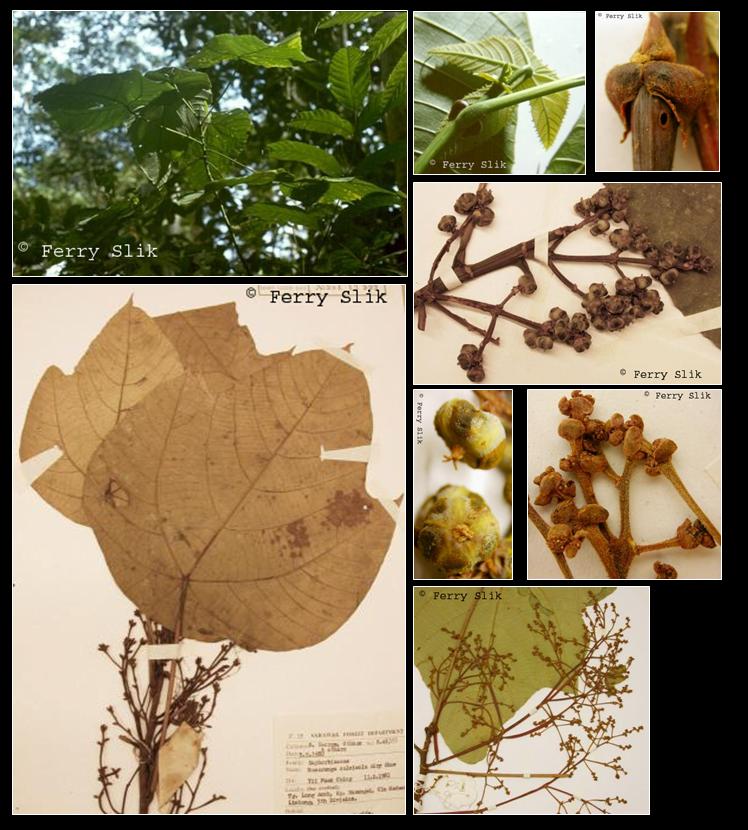Macaranga bancana (Miq.) Mull.Arg., in DC., Prodr. 15, 2 (1866)
Latin for 'from Bangka' an island of the coast of Sumatra.Synonyms
Macaranga tenuifolia Müll.Arg.
Pachystemon bancanus Miq.
Tanarius bancanus (Miq.) Kuntze
Tanarius tenuifolius (Müll.Arg.) Kuntze
Diagnostics
Understorey tree up to 23 m tall and 17 cm dbh. Twigs hollow, ant inhabited.
Stipules red, recurved, providing food for ants. Leaves alternate, simple to
3-lobed, peltate and palmately veined, glabrous to hairy below, whitish below.
Flowers ca. 1 mm diameter, green-whitish, clustered together within bracts on
branched inflorescences. Fruits ca. 9 mm diameter, green-white-yellowish,
4-5-lobed, dehiscent capsules with glandular patches, seeds with reddish aril.
Description
Abundant small tree to 23 m tall, but reproductive from only 2-3 m tall; twigs 4-9 mm in diam.,
glabrous or rarely with scattered minute ferrugineus hairs towards the apex, not glaucous, hollow,
housing ants. Bark pale-brown to whitish, mottled, smooth with small lenticels, hoop-marked.
Stipules broadly ovate, 6-8 by 6-9 mm, red-brown when fresh, usually finely furfuraceous on the
base of the adaxial surface when young and becoming glabrous, the pair completely encircling the
twig, succulent, recurved, producing food-bodies on the abaxial surface, usually 2-4 pairs present
on the shoots. Leaves: petioles terete, slender, 8-24 cm long, not glaucous, glabrous; blades
broadly ovate, 16-32 by 12-25 cm, trilobed to rarely just tricusped, variably dissected to
1/8-1/2 of the leaf length, central lobe broad sometimes constricted near the base, lateral lobes
ascending and 2.5-5(-7) cm wide, rather shallowly peltate, petiole insertion 1-4 cm from margin,
base broadly rounded, margin entire, apices narrowly acute, adaxial surface glabrous or scattered
with fine ferrugineus hairs along the veins when young, abaxial surface glabrous with the veins
sparsely to evenly covered in minute crisped silvery hairs; 1st degree venation palmate with 7-8
prominent veins, 2nd degree venation scalariform and rather closely spaced usually with 14-16 pairs
of veins arising from the midrib, curving upwards slightly near the leaf margins and running into
the margin and terminating in tiny (c. 0.3 mm) narrow conical nectaries; young leaves reddish-brown,
densely minutely ferrugineus hairy, soon becoming glabrous. Staminate inflorescences furfuraceous,
reddish-brown, paniculate, erect, 10-20 by 5-15 cm, densely ferrugineus tomentose, particularly
dense towards the apex and becoming more scattered to rarely almost glabrous at the base, with the
hairs also slightly longer towards the base, up to 4 axis orders with the distal branches
characteristically looping and convoluted, main axis flattened, first pair of secondary branches
opposite with accessory branches; bracts ovate, 3-6 by 2-3 mm, margin entire, apex acute, finely
ferrugineus pubes cent on both surfaces and the margin, caducous; flower clusters with 15-25(-30)
flowers, spirally arranged and scattered along ultimate inflorescence branches: bracteoles small,
broadly ovate to transversely elliptical, 1.5-2.5 by 2-4 mm, enclosing flower clusters, margin
entire, apex rounded or with a short broad acute tip, very densely covered with minute ferrugineus
hairs and yellow granular glands. Staminate flowers c. 0.7 mm long, sessile; sepals fused, splitting
irregularly to c. 1/3, apex densely covered in minute red-brown hairs; stamens 1, anthers 3-locular.
Pistillate inflorescences paniculate, erect, 3-11 by 3-7 cm, stout, scattered with short ferrugineus
hairs towards the base and more dense towards the apex, up to 3 axis orders, secondary branches
opposite and usually with accessory branches; bracts elliptic, 5-8 by c. 3 mm, apex acute, abaxial
surface scattered with minute ferrugineus hairs and tiny yellow granular glands particularly towards
the base, adaxial surface scattered with ferrugineus hairs, caducous. Pistillate flowers c. 2 mm
long, solitary in bract axils; calyx urceolate, 1.0-1.5 mm long, densely ferrugineus pubescent and
scattered with yellow granular glands, persistent, splitting irregularly as ovary expands; ovary
4-(sometimes 5-)carpellate, c. 1.5 mm long: styles c. 1 mm long, fused at base, free and spreading
from c. 1/2 of the length, persisting to form a prominent 2-3 mm long crown at fruit apex; stigma
not dissected. Fruits 5-7 by 10-11 mm, bright green and slightly reddish on the sutures when fresh,
subglobose, compressed, sessile, with scattered ferrugineus hairs on the sutures and at the base of
the styles, with one discrete glandular patch on each carpel wall developing into a short pointed
swelling c. 1-2 mm long, covered in yellow-green, sticky exudate. Seeds subtriangular-ovoid,
c. 4 mm in diam., black, with shallow coarse grooves and a small cruciform scar at the columella
attachment point, encased in a fleshy bright pinkish to orange-red aril. [from Flora Malesiana]
Ecology
In disturbed sites in mixed dipterocarp and swamp forests up to 700 m
altitude. Often on alluvial sites such as riversides, but also common along
roadsides on sandy soils. It is common on both clay and sandy soils, although
clearly prefers the latter, which may in part be due to the water status of
those soils, as it is also quite a common colonist of wet gullies along roadsides,
alluvial forest areas, and the margins of degraded peat swamp forests.
Distribution
Peninsular Thailand, Peninsular Malaysia, Sumatra, Java, Borneo, Philippines (Palawan).
Local names
Borneo: Benuah, Layang-layang, Purang, Sedaman, Sedaman laki.
